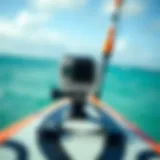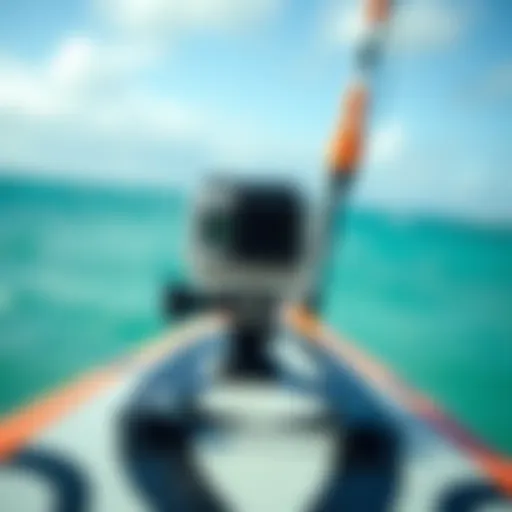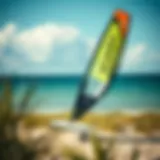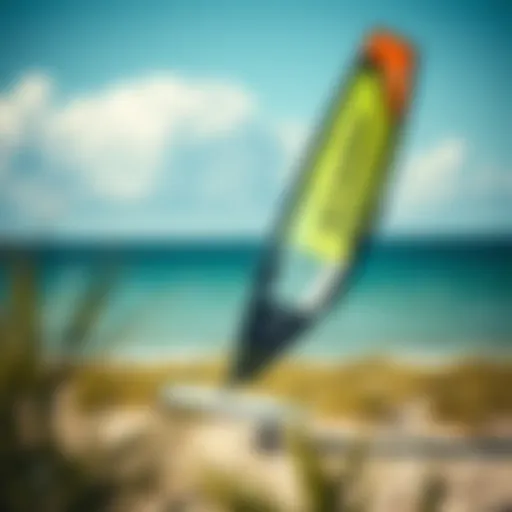Discovering the Fascinating World of Giant Kites


Intro
As we look up to the sky, we often notice the vibrant spectacle of kites soaring gracefully against a blue backdrop. Among these, the really big kites stand out, captivating the imagination of onlookers and practitioners alike. These magnificent structures not only serve as recreational instruments but also double as art demonstrations, cultural displays, and tools for understanding wind dynamics.
Diving deeper, this piece intends to unravel their complexities, peeling back the layers of construction, design, and the essential techniques involved in flying them.
Gear Selection
To embark on your journey into the world of big kites, understanding gear selection is crucial. The right kite can make all the difference between a lackluster experience and an exhilarating flight.
Types of Kites
Big kites come in various shapes, each suited for different conditions and purposes. Here are a few categories worth noting:
- Single-Line Kites: These are typically larger and easier to fly, making them suitable for beginners. Their construction often involves a simple frame design covered with fabric.
- Dual-Line Kites: These require more skill since they allow for more control over maneuvers. Enthusiasts looking to perform tricks frequently opt for this type.
- Power Kites: Designed for kitesurfing and specialized activities, these kites pack a punch when it comes to generating lift and speed.
- Art Kites: Resembling large artworks, these kites exhibit intricate designs and are often flown at festivals where aesthetics take the center stage.
When you choose your kite, consider factors like wind conditions, your skill level, and the specific activities you wish to pursue.
Choosing the Right Board
The board is another vital piece of gear, particularly for kiteboarding. Selecting the right one involves a few considerations:
- Size and Shape: Boards come in various widths and lengths. Wider boards tend to be more stable in lower winds, while narrower boards allow for higher speeds.
- Rocker: This refers to the curve of the board's bottom. A board with more rocker is easier to maneuver in choppy water but may not provide the same speed as a flatter board.
- Material: Most boards are made from lightweight materials, often layered for resilience while keeping the weight low without sacrificing durability.
An appropriate board not only complements your kite but also suits your riding style, maximizing your performance in the water.
Always remember: The right combination of kite and board can turn a good day into a great one, ensuring that you can tackle any challenge the winds throw your way.
Skill Development
Once equipped with the right gear, the next step is developing the skills needed to enhance your experience. The focus should be on mastering essential techniques and progressing systematically.
Essential Techniques
For both flying kites and kiteboarding, honing core skills is vital. Here’s a breakdown:
- Launching: Knowing how to launch your kite effectively can save you from many mishaps. Make sure to check the wind direction, use a solid launch technique, and get assistance if needed.
- Controlling Altitude: Practice moving your kite in the wind window to control its height, a crucial skill for both stability and performance.
- Self-Rescue Procedures: Always familiarize yourself with self-rescue techniques. Ensuring you can safely return to shore is paramount, especially in challenging conditions.
Progression Tips
Improvement takes time, and progression comes with practice. Here are some tips to help you level up:
- Take Lessons: Consider enrolling in courses or private sessions with experienced instructors. This hands-on experience can dramatically accelerate your learning curve.
- Practice Regularly: Consistency is key. Try to fly or ride in various conditions to adapt to changing environments.
- Join a Community: Engaging with fellow kite enthusiasts can provide valuable insights, support, and camaraderie. Online platforms such as Reddit or local clubs can be excellent resources.
Through practice and the right guidance, the art of flying big kites can transform from a simple hobby into a deeply satisfying pursuit, offering both challenges and joy.
Finale
This exploration into the domain of really big kites reveals their multifaceted nature, emphasizing not just technical knowledge but also the community and culture surrounding them. Whether it's crafting the ideal setup or developing your skills, every aspect contributes to a more rewarding engagement. As you dive deeper into this thrilling world, remember to respect nature and adhere to safety protocols, ensuring a responsible approach to this exhilarating pastime.
For further insights and resources, consider visiting Wikipedia's Kiteboarding page or Britannica. Happy flying!
The Anatomy of Large Kites
Understanding the anatomy of large kites is crucial for anyone looking to maximize their experience, whether in flying or designing them. Each component plays a significant role, not only in how the kite performs but also in ensuring safety and longevity. From the material choices to the intricacies of design principles, every detail counts.
Materials Used in Construction
Fabric Types
When it comes to fabric types, the choice can make or break the performance of a large kite. Ripstop nylon is a popular material. Its strong yet lightweight nature allows for durability while minimizing weight. Many kite fliers appreciate that it can endure harsh winds without easily tearing. On the flip side, polyester is another common choice, favored for its resistance to stretching, which helps maintain the kite's shape over time. However, its heavier weight could affect how the kite behaves in light winds.
A common consideration amongst serious kite enthusiasts is the balance between weight and durability. An ideal fabric not only withstands the elements but is also relatively easy to pack and transport. In this article, you will learn why the right fabric matters — it directly influences lift, stability, and overall flying experience. In environments where variability in weather is common, choosing the right material can save untold frustration.
Frame Materials
Frame materials, too, are pivotal in the kite’s anatomy. Lightweight fiberglass frames have been widely embraced, as they are resilient and contribute to the kite’s overall strength. Though more expensive, carbon fiber poles offer exceptional rigidity while still managing to be light, a top-tier preference for kiteboarders chasing performance under demanding conditions.
One notable downside of frame materials is their susceptibility to breakage when faced with tough landings or high winds. However, knowing how to balance cost with performance can make all the difference in kite selection, especially for those new to the sport. The task of choosing the right frame boils down to what matters to the flyer: portability, resilience, or price.
Harness Compatibility
Harness compatibility is another fundamental aspect often overlooked by novices. A well-selected harness not only makes flying more comfortable but maximizes control over the kite. Most large kites come with standard options; however, ensuring the harness fits snugly is essential. Brands like Ocean Rodeo and Naish provide harnesses that cater specifically to the broad applications demanded by kiteboarding.
The unique advantage of harnesses lies in their various designs, which can support different flying styles. For example, a spreader bar in a harness allows for better weight distribution which directly accounts for rider comfort over longer sessions. It's worth noting, though, that not all harnesses provide the same level of support, leading to discomfort if the wrong fit is chosen. Keeping an eye on compatibility before making a purchase is vital for an enjoyable experience.
Design Principles
Shape Variations
Shape variations in kite design yield economical and performance benefits. Most enthusiasts are captivated by the distinct looks of delta, box, and parafoil kites. Each shape offers unique performance traits in various wind scenarios, affecting lift and stability. A delta kite, for instance, performs remarkably well in turbulent winds, attributed to its pointed shape that cuts through air effectively.
What’s particularly interesting to note is that the choice of shape can significantly influence both aesthetic appeal and flying characteristics. Generally speaking, while more ornate shapes may gather attention at festivals, the traditional and functional designs often lead to better performance out on the water.
Aerodynamics
Aerodynamics surely plays a critical role in a kite's flight. Lift can be increased by optimizing the angle at which the kite meets the wind, a harmonious interaction that determines how gracefully the kite will float in the sky. Canopy design also influences airflow, which in turn affects lift and drag. Understanding these principles is crucial, particularly for those engaged in competitive kiteboarding.
Many enthusiasts appreciate that diving deep into aerodynamics extends beyond mere hobbyist interest; it also enriches one’s skill set. A well-designed kite isn’t merely about looks; maximizing aerodynamic efficiency keeps a kite steady, helps it to climb higher, and enhances the overall riding experience.
Weight Distribution
The significance of weight distribution shouldn’t be underestimated. It is one of those facets that often requires experimentation. An unbalanced kite will not fly smoothly, leading to frustrating flight experiences. Adjustments in frame stiffness or even the placement of reinforcing bands can result in vastly different flying characteristics.
In the making of a large kite, weight distribution allows for balance and helps dictate how the kite responds to gusts and pulls. When considering kite designs, those who grasp the principles of weight distribution can experiment with their kites to tailor performance according to their unique riding style.
Ultimately, understanding the anatomy of large kites is an investment in mastering both the craft and the sport. By examining the materials, frame selections, and design principles, a kiteboarder can elevate their skills while enjoying a harmonious connection with the wind and waves.
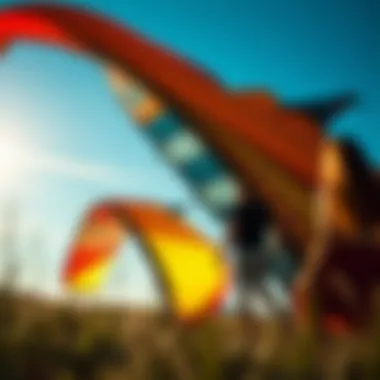

The Physics of Really Big Kites
Understanding the physics behind large kites is pivotal for anyone involved in kiteboarding, whether it be enthusiasts, instructors, or event organizers. This topic offers insights into how kites interact with the wind and how different design elements contribute to the overall performance. Grasping these principles not only enhances the flying experience but also plays a key role in ensuring safety.
Lift and Drag
The dynamics of lift and drag are crucial for fully appreciating how kites soar high in the sky.
The Role of Wind Speed
Wind speed plays a central role in how kites lift off the ground and maintain altitude. When wind speeds increase, kites generate a stronger lift force, enabling them to catch more air and stay aloft. A high-speed wind can be a kite's best friend, creating that exhilarating feeling as it dances in the sky.
However, there's more to the story. Too much wind can lead to difficulties. High winds can make it challenging for less experienced flyers to control larger kites, potentially leading to accidents. Therefore, it's essential to match the kite with the right wind conditions for a safe and enjoyable flight.
Angle of Attack
The angle of attack pertains to how the kite's surface meets the wind. A proper angle encourages optimal lift; if the kite's leading edge is angled too far up or down, lift can diminish. A well-defined angle of attack is critical for efficient flying, allowing the kite to maximize lift while minimizing drag.
Many kiteboarders find that adjusting their kite's angle during flight can significantly impact performance. Understanding this principle can lead to more agile maneuvers on the water. It provides opportunities for catchy tricks or smooth cruising, depending on the adjustements made.
Stability Issues
Stability issues often arise when dealing with large kites, mainly due to their size and design. A kite must maintain balance in changing wind conditions to prevent sudden dives or loss of control. Different shapes and configurations can influence a kite's stability. This makes understanding stability particularly beneficial for advanced practices, as it assists in better overall control.
Successfully managing stability not only enhances performance but also reduces the risks involved. Safety is a priority, and kite flyers need to be mindful of how their kite responds to the whims of the wind.
Control Mechanisms
Control mechanisms are vital when handling large kites, influencing their response to wind and pilot movements.
Tension Systems
Tension systems contribute to how effectively a kite responds to pilot inputs. These systems help maintain the right amount of control and influence the shape and stability of the kite. Understanding these systems is essential not only for skilled flyers but also for those just getting started.
Tension systems can vary widely in complexity. Some models might feature multiple lines and adjustments, while others offer simpler configurations. A basic understanding of the tension mechanisms can drastically improve the users' flying experience, giving them the control they need to navigate various conditions successfully.
Bridle Configurations
Bridle configurations are essential for kite adjustments and overall handling. The bridle, the system of lines that connects the kite to the control lines, impacts how the kite flies in the wind. A well-set bridle can enhance a kite's lift while minimizing drag, making it a preferred choice for optimal performance.
Each bridle design presents distinct characteristics that can suit different flying styles. Understanding these configurations can guide users in making appropriate choices that match their skill level and preferences.
Deployment Techniques
Deployment techniques are crucial for ensuring an effective launch and retrieval of the kite. A well-executed launch can make a world of difference, especially with larger kites, where the risk of tangling or crashing is higher. Understanding the right sequence of actions to launch a kite smoothly can lead to an enjoyable flying experience.
Applications in Kiteboarding
Kiteboarding has risen to prominence as a thrilling sport that combines elements of surfing and wind-powered kiting. The significance of large kites in this arena cannot be overstated. These behemoths not only enhance performance but also influence the style and technique that riders employ on the water. Understanding how large kites function within kiteboarding helps enthusiasts and newcomers alike make informed choices about equipment and conditions.
Performance Characteristics
Speed and Maneuverability
Speed and maneuverability are at the forefront of what makes a kiteboarding experience exhilarating. Large kites, while often perceived as bulkier, can actually be engineered for swift aerial action. This capability stems primarily from their specific design and how well they capture airflow. These kites are designed for maximizing lift while maintaining a balance between speed and control. Riders find themselves zipping across the water, with the added advantage of dynamic steering that large kites can provide.
One key characteristic of speed is the size of the kite, which directly correlates to how much wind energy it can harness. A larger surface area captures more wind, propelling the boarder forward at a quicker pace. However, the trade-off can be a learning curve, as superior handling skills are requisite for effectively managing larger kites in high winds. Thus, while the speed can be immensely thrilling for experienced kiteboarders, it may present challenges for novices.
Surf and Freestyle Benefits
Large kites bring unique advantages to the surf and freestyle genres of kiteboarding. The power they generate allows riders to perform tricks with greater ease—heightened lift and strong traction let athletes soar higher and stay aloft longer. Riders can execute daring maneuvers, showcasing their skills while attempting flips and spins that demand precision.
Moreover, the large wing’s stability in the air permits riders to focus less on keeping control and more on exploring new tricks. Nonetheless, beginners might find these kites intimidating due to their tendency to pull strongly, which can lead to mishaps if not managed properly. Therefore, proficiency and safety awareness are essential factors to consider when selecting a large kite for surf and freestyle activities.
Wind Conditions for Best Use
Understanding wind conditions is vital when it comes to kiteboarding, and large kites thrive in specific scenarios. These kites generally excel in stronger winds, where their surface area can effectively harness more energy, allowing for better performance. Kiteboarders often find that they can ride effectively in higher winds with greater stability compared to smaller kites.
An interesting feature of larger kites is their capability to maintain power you ride forward, even when wind conditions are not ideally favorable. This allows kiteboarders to take to the water when conditions might typically be viewed as borderline too gusty. That said, it's essential to keep in mind that safety must always come first. Riding in very strong winds can pose significant risks, thus having a comprehensive grasp of conditions can make a world of difference.
Innovations in Design
Advancements in Materials
The evolution of kiteboarding is tied closely to advancements in materials. Modern large kites utilize high-tech fabrics that are both lightweight and durable, enhancing performance while ensuring longevity. These materials not only allow for more agile movements but also sort out how kites withstand wear and tear from saltwater and high winds.
The powerful strength-to-weight ratio of materials such as ripstop nylon or polyester is compelling for kiteboarders. These fabrics enable larger constructions without a corresponding increase in weight. As a result, enthusiasts can enjoy a range of performance benefits without compromising on maneuverability or the signature thrill of speed. However, as with most innovations, it’s worth considering the cost, as high-quality kites often demand a premium price.
Technological Integration
Another intriguing development is the integration of technology in large kites. With GPS and smart sensors embedded into modern designs, kiteboarding has stepped into the techno-age. Riders can track performance metrics, such as speed and altitude, enhancing the experience of every session.
Furthermore, some brands have even started incorporating automated systems that assist in managing the kite based on real-time wind conditions. Such technology can facilitate a smoother riding experience, especially for less experienced boarders. Yet, with this level of dependence on technology, comes the potential for mechanical issues that may arise unexpectedly. Therefore, knowledge about kite systems remains crucial for effective navigation in the open waters.
Future Trends
Looking ahead, future trends signal an exciting time for large kites in kiteboarding. Emphasis on eco-friendly materials is reshaping the industry as brands seek to reduce the environmental impact of their products. Innovations are anticipated to not only enhance performance but also promote sustainability—a worthy goal for global kiteboarding aficionados.
Additionally, advances in aerodynamic design could pave the way for even more efficient kites that require less wind speed to perform optimally. This might open doors for new riders in varied conditions, broadening the appeal of kiteboarding as a sport. Although the road ahead may present challenges—like the balance between technological advancement and traditional craftsmanship—the future looks promising for kiteboarders globally.
Cultural Significance
The cultural significance of large kites extends far beyond their mere recreational use. They embody traditions, skills, and communal gatherings that date back centuries. By exploring the cultural layers of kite flying, we gain insight into not only the art form itself but how it has transformed communities and built connections between people from varying backgrounds. The vibrancy of kite festivals adds to their cultural weight, and their roles vary significantly around the globe.
Kite flying, once seen solely as a children's pastime, has become an integral part of local customs, drawing families and friends together. Beyond values of togetherness, the artistry involved in kite-making also reflects broader themes found within specific cultures, showcasing that every kite has a story to tell.
Kite Festivals Around the World


Historic Origins
Kite festivals boast a rich tapestry of history that can be traced back thousands of years. Originating in places like China, where kites were once used for military signaling, their use has evolved into colorful celebrations globally. This historical context serves as a backdrop for the myriad festivals we observe today, such as the International Kite Festival in Gujarat, India, where kites are flown in vibrant hues to mark Makar Sankranti.
The crucial historic aspect is how kites have been symbols of hope, messages, and even markers of social significance. This historical consciousness is vital for reinforcing the collective identity of participating communities, offering both nostalgia and continuity.
Modern Celebrations
Modern celebrations have taken the form of spectacular events that attract enthusiasts from all corners of the globe. Festivals like the AKA's Kite Festival in Ocean City, New Jersey, showcase everything from competition flying to stunning aerial displays. These gatherings are culturally significant because they unite people irrespective of nationality or background, allowing participants to partake in an exchange of ideas, techniques, and experiences.
The remarkable feature of modern kite festivals is their ability to blend tradition with contemporary artistry. Local artisans present their best creations while engaging in friendly competition, making the experience both a feast for the eyes and an opportunity for cultural exchange, resulting in deeper understandings among attendees.
Global Participation
Kite festivals today feature global participation that enriches the experience for all. With international kite flyers sharing the sky, these events highlight a collective passion that transcends borders, cultures, and languages. It’s fascinating to see individuals from Japan to Norway gracefully navigating their kites in unison.
The distinctive advantage of global participation lies in its capacity to strengthen bonds among kite enthusiasts. When people share the same passion, barriers dissolve. This unity fosters a sense of global community, where not only skills and competition matter but also mutual respect for diverse cultural approaches to kite making and flying.
Artistry and Craftsmanship
Design Aesthetics
The aesthetics of kite design plays a pivotal role in the larger conversation about their cultural significance. Often, kites serve as canvases for artistic expression, integrating colors, shapes, and materials that reflect local traditions and tastes. For instance, the elaborate designs seen in Chinese dragon kites are not only stunning but also illustrative of important cultural narratives.
The key characteristic of design aesthetics is that it is versatile. Depending on context, a kite can symbolize anything from a celebration to a bearing of cultural identity, making it a beneficial element for understanding kites' role in society. Such visuals can spark conversations about cultural heritage, pride, and the evolution of artistic expression.
Cultural Themes
Kites often carry significant cultural themes embedded in their designs and use. For example, in the Indian subcontinent, certain patterns represent auspicious beginnings or rites of passage. They may symbolize the arrival of a new season or respect for nature.
Emphasizing cultural themes provides an incredible opportunity to educate others about notions of spirituality, history, and environmental consciousness. A kite becomes a messenger of these themes, essentially embodying the values and beliefs of the communities that create and fly them.
Handcrafted vs. Commercial Designs
The debate over handcrafted versus commercial designs creates a fascinating layer to the discussion of kites' cultural significance. Handcrafted kites often represent a cherished craftsmanship, where artisans pour their skills and stories into each piece. These designs are unique, connecting the flyer to a lineage of tradition and artisanal know-how.
In contrast, commercial designs often yield efficiency and accessibility. While they can reach a wider audience, they sometimes lack the personal touch that handcrafted options provide. The choice between them can reflect individual values: a preference for community connection versus practicality in modern life.
With all of this in mind, it’s clear that the world of kites is far from frivolous; it is a remarkable blend of culture, artistry, and community that deserves a deeper exploration.
Safety Considerations
When it comes to flying large kites, safety cannot be overstated. The thrill of launching a magnificent giant kite into the sky comes with a set of responsibilities. Acknowledging the need for safe practices not only enhances the kite-flying experience, but it also protects enthusiasts, spectators, and the environment. From pre-flight preparations to understanding possible hazards, each aspect of safety plays an essential role when engaging in this vibrant activity.
Guidelines for Safe Flying
Pre-Flight checks
Before taking to the skies, conducting thorough pre-flight checks is a must. This aspect ensures that all components of the kite are functioning! Each knot should be tight, fabric free of damage, and the frame intact. These checks contribute significantly to a successful flying session, ensuring the kite won’t unexpectedly plummet or, worse yet, harm someone nearby. By focusing on preventive measures, kite flyers proactively reduce the risk of accidents. One key characteristic of pre-flight checks is their simplicity. A checklist can be easily created to streamline this process, transforming something that could become hectic into a smooth routine.
It's essential to mention that some might overlook the importance of this step, thinking that they know their kite well enough. However, even the most seasoned flyers can benefit from a fresh perspective before launching. This practice stands out as a wise choice, helping to visualize every aspect of kite safety before experiencing the joy of flight.
Environmental Awareness
The element of environmental awareness is equally crucial for kite enthusiasts. Understanding the surroundings before launching a kite can prevent potential accidents and disturbances. This aspect includes recognizing nearby structures, trees, and natural obstructions, which could become hazards when a kite takes off. Also, being aware of weather conditions, wind patterns, and existing aerial navigation rules is fundamental.
This characteristic makes environmental awareness a beneficial choice as it fosters not only personal safety but also respect for nature. A unique feature of this awareness is its community impact—by practicing responsible kite flying, enthusiasts set a positive example for others. Neglecting environmental considerations might lead to accidents, and even the potential harm to wildlife. Thus, enhancing one’s environmental awareness couldn't be more vital.
Personal Safety Gear
Personal safety gear is another worthy consideration for kite flyers. Wearing appropriate safety equipment, such as helmets or impact vests, can go a long way in ensuring safety. The inclusion of safety gear mitigates potential injuries caused by sudden falls or unexpected encounters with other kite flyers. This characteristic emphasizes how being well-prepared adds a layer of protection.
Using personal safety gear is a practical choice for anyone stepping into the kite-flying arena. One unique aspect of this gear is its adaptability; custom options exist based on personal preference and local conditions, ensuring comfort while maintaining safety. However, the drawback for some may be the additional cost of specialized gear. Nonetheless, for the love of being airborne with a giant kite, safety should never take a backseat.
Managing Risks
Risk management is a guide for how to identify and navigate questionable situations while kite flying. By learning to address challenges promptly, kite enthusiasts can experience a more enjoyable and safer flying experience.
Identifying Hazards
Identifying hazards is critical for a successful kite-flying day. This involves understanding the risks associated with kite flying, such as wildlife, electrical lines, and weather variations. By being able to pinpoint these risks, flyers equip themselves with the foresight needed to navigate safely. This key characteristic of identifying hazards serves as a foundational aspect of kite safety, promoting a proactive approach.
The unique feature of this identification is its adaptability; conditions may change rapidly, thus requiring keen observation. By not recognizing hazards, the risk of injury or accidents rises significantly. Therefore, cultivating an awareness of one’s surroundings is essential, preventing unfortunate events.
Emergency Protocols
In the unfortunate event of an incident, having emergency protocols in place can be life-saving. These procedures should outline the steps to take in various scenarios, such as if a kite is stuck in an obstruction or someone sustains an injury. The key characteristic of these emergency protocols lies in their comprehensive nature, fostering preparedness among flyers.
The unique aspect of these protocols is their emphasis on team cooperation; kite flying often includes groups, so a shared understanding of these procedures can enhance group safety. However, the challenge is ensuring everyone involved is familiar with the protocols, as neglecting this could lead to confusion in critical moments. Having well-defined emergency protocols ensures that everyone knows just what to do when it matters.
Insurance Considerations
Exploring insurance considerations is also a valuable avenue as it lends a safety net to kite flyers. Whether it’s personal liability or coverage for equipment, assessing the risks involved helps flyers make informed decisions. The key characteristic here is the potential peace of mind that insurance provides, alleviating worries about possible financial impacts from an accident.
One unique feature of insurance considerations is the ability to customize policies based on personal needs and kite-specific risks. However, the cost of premiums may deter some from obtaining insurance, leaving them vulnerable. Weighing the options and understanding insurance can lead to better preparedness while enjoying the thrill of kite flying.
Environmental Impact
When it comes to understanding the landscape of really big kites, it is crucial to consider their environmental impact. The creation and utilization of these large kites extend beyond mere recreational amusement. They intersect with environmental considerations that can influence sustainability and ecological health. By assessing how these kites affect our surroundings, enthusiasts can make informed choices that not only enhance their kiteboarding experience but also protect the planet for future generations.
Sustainable Practices
The emphasis on sustainable practices is what separates environmentally-conscious kite enthusiasts from the rest. Kite construction and usage can be enhanced by integrating eco-friendly tactics that mitigate negative impacts on nature.
Eco-Friendly Materials
Using eco-friendly materials in kite construction is one way to help lessen environmental footprints. Kites made from recycled fabrics, such as recycled nylon or polyester, are gaining traction because they lessen landfill waste. These materials typically have a lower carbon footprint than virgin materials, making them an appealing choice for eco-minded kite designers. While they might shine in sustainability aspects, some kite enthusiasts worry about durability. Still, many find the trade-off worth it, prioritizing ecological responsibility without sacrificing performance in the air.
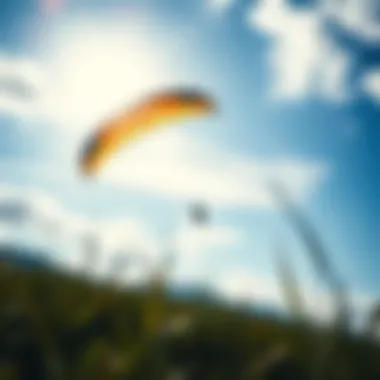

Waste Management Procedures
Waste management is another vital aspect directly tied to kiteboarding. When organizers plan events, they often implement waste procedures that emphasize clean-up after flying kites. This includes ensuring that kite lines, fabric scraps, and other refuse do not end up in natural settings. Using designated recycling bins and encouraging participants to clean up not only aids in protecting local wildlife but fosters a community spirit dedicated to preserving the environment. However, while many enthusiasts support this initiative, some find its implementation varied depending on locations and local environmental policies.
Recycling Initiatives
Recycling initiatives contribute to creating a sustainable cycle in kiteboarding. Manufacturers are beginning to adopt practices where old kites can be returned and recycled into new products, effectively closing the loop. This not only reduces waste but also raises awareness among enthusiasts about the importance of responsible kite usage. Nonetheless, these initiatives can be challenging due to varying regulations in different regions, yet the ability to promote recycling awareness within the community helps foster a culture of environmental responsibility.
Contributions to Conservation Efforts
Beyond sustainable practices, really big kites play significant roles in broader conservation efforts. They offer an opportunity to engage communities and support environmental programs actively.
Funding Environmental Programs
Funding environmental programs linked to kiteboarding can yield considerable benefits. Often, proceeds from kite festivals and competitions are redirected to local conservation projects. This supports the maintenance of natural habitats conducive to both wildlife and kite activities. The community recognition of this fundraising can elevate kiteboarding from a recreational sport to a powerful avenue for creating change. However, critics may argue that reliance on events for consistent funding might not be sustainable long-term.
Awareness Campaigns
Awareness campaigns around kiteboarding not only highlight the joy of flying kites but also focus on environmental education. Participating organizations often run campaigns to educate attendees about the local ecosystems and their protection. Events that celebrate kites can also serve as platforms for other environmental messages, making it a two-fold advantage. The challenge lies in ensuring that the messages resonate deeply enough to prompt genuine engagement from participants.
Community Involvement
Community involvement plays a central role in fostering a shared commitment to conservation within the kiteboarding ecosystem. Local groups frequently organize discussions about environmental initiatives, presenting a voice to enthusiasts who care about the land and sea around them. Meetings and workshops can lead to collaborative efforts in clean-up days, planting trees, or protecting shoreline areas that kiteboarders frequent. The issue we face is ensuring that such efforts remain consistent, drawing continuous community engagement and commitment to preserving the natural beauty we cherish.
Choosing the Right Kite
Selecting the proper kite can greatly affect your flying experience, be it for leisure, competitive kiteboarding, or recreational activities. The right choice not only enhances performance but also ensure safety during operation. It’s essential to delve into significant factors like skill level, style preference, and local conditions to make an informed decision.
Factors to Consider
Skill Level
In the realm of kites, skill level plays a fundamental role in identifying the right gear. Beginners may work well with a simpler kite, often leading to a more enjoyable learning process. Notably, a novice-friendly kite, generally lighter with fewer complexities, can give users confidence as they develop their skills. Conversely, experienced flyers might favor a kite that offers advanced features or performance capabilities. Overall, the suitable choice aligns with both ability and familiarity, shaping the trajectory of one’s kite flying journey. It is worth mentioning, however, that jumping into more complex designs without adequate preparation could lead to mishaps.
Style Preference
When it comes to style, this preference dictates how an individual engages with the sport. Whether you lean toward freestyle, wave riding, or just casual flying, there’s a kite suited for each inclination. For example, freestyle enthusiasts protect versatility in their kites, allowing for twists and turns with ease. In contrast, wave riders might choose kites designed for stability and easier handling in unpredictable ocean breeze. Choosing a kite that resonates with one's personal style makes the experience all the more gratifying, aligning the kite’s capacities with the user's ambition. Keep in mind that mismatched styles can not only hinder performance but also present irritations during your kiteboarding outings.
Local Conditions
Local conditions are a crucial aspect to weigh while selecting a kite. The wind patterns and the area’s environment can significantly affect kite performance. If you're situated in a coastal area with consistent onshore winds, a larger kite is often beneficial, as it contributes to ample lift and stability. Alternatively, if you find yourself in regions prone to gusty winds such as mountainous terrain, a smaller, more responsive kite could be a better fit. Environmental understanding is pivotal; it helps users choose kites that can handle the distinct behaviors of local winds efficiently. Mismatched kites for specific locations can lead to frustration and, more importantly, safety concerns during flights.
Recommended Models
Top Brands
The kite market encompasses brands that specialize in various designs crafted from innovative materials. Brands such as Duotone, Cabrinha, and North Kiteboarding stand out due to their commitment to quality and performance. These manufacturers often conduct extensive research and development, providing kites that are not only durable but also fine-tuned for optimal flight behavior. Their long-standing reputation stems from user feedback and a dedication to performance excellence. By considering these brands, flyers can trust that they are investing in equipment that can withstand the demands of frequent use and unpredictable conditions.
Budget Options
For those working within financial constraints, finding budget-friendly options is vital. Brands like AONIC and Slingshot offer affordable kites without sacrificing quality. These models cater to newcomers and casual users, providing basic functionality for enjoyable experiences. While they may lack some advanced features found in higher-end counterparts, they are nonetheless reliable choices that don’t put too much strain on the pocket. However, prospective users are often advised to read reviews and research individual models to ensure they meet specific needs.
Customization Possibilities
Customization can transform the kite flying experience, allowing enthusiasts to tailor their equipment to fit unique demands. Some brands offer options that let users select colors, sizes, and even specific features like strap adjustments. A customizable kite enables flyers to align with personal taste while ensuring functionality matches their skill level and style. However, it’s worth mentioning that customization can sometimes increase costs, so budgeting accordingly is beneficial before diving into personalized options.
Remember: The right kite not only elevates your experience but also ensures that each flight is both exciting and safe. Choose wisely!
Kiteboarding Destinations
Kiteboarding destinations play a pivotal role in the experience and culture surrounding large kites. These locations not only provide the right conditions for flying but also shape the social dynamics of kiteboarding. The thrill of harnessing the wind while surrounded by beautiful landscapes attracts enthusiasts and professionals alike. This section will highlight key elements such as global hotspots for large kites, seasonal considerations, and the rich local cultures that enhance the kiteboarding experience.
Global Hotspots
Best Locations for Large Kites
The world is dotted with extraordinary sites where large kites can soar against the sky. In fact, places like Cape Hatteras in North Carolina and Tarifa in Spain are renowned for their consistent winds and wide-open spaces. The specific aspect that makes these locations exceptional is their favorable wind patterns, which are critical when addressing the needs of kiteboarders, especially those flying larger kites.
One key characteristic of these hotspots is their infrastructure geared towards kiteboarding. For instance, Tarifa has a vibrant community of kite schools, equipment rental shops, and eateries that cater specifically to kiteboarders. The unique feature here is the intensity of the wind—steady and predictable—that allows for extended flying sessions. This is a beneficial choice for both novices and experienced fliers, as it facilitates skill development and confidence building.
Seasonal Considerations
Understanding seasonal conditions at kiteboarding hotspots is crucial for optimizing the kite-flying experience. In sites like Maui and Dubai, the wind patterns shift with the seasons. Peak conditions often emerge in summer months when thermals provide reliable winds. The dry season particularly favors kiteboarding, as reduced precipitation means clearer skies and more consistent wind flow.
This aspect is beneficial since it allows kiteboarders to plan their trips around optimal conditions. For example, the windy summer months in the Canary Islands provide not only superior kiteboarding conditions but also attract various international events, highlighted by community engagement and workshops. However, an important drawback to note is that peak seasons can lead to crowded beaches, which might limit practice space.
Local Culture and Community
The local culture surrounding kiteboarding is often vibrant and welcoming. In locations like Cumbuco in Brazil or Dakhla in Morocco, it’s not just about the kites; it’s about the connections made within these diverse communities. Kiteboarders often form tight-knit groups over shared experiences, and the communal events add to the ambiance.
What’s distinctive about these communities is their hospitality and willingness to share knowledge. This kind of cultural interaction enriches the kiteboarding experience for both locals and visitors by encouraging skill exchanges and building friendships. The advantage of this local culture is the sense of belonging that emerges, making each kiteboarding trip not just an adventure but a journey into the heart of a new community.
Upcoming Events
Major Competitions
Major kiteboarding competitions occurring throughout the year capture the thrill of large kites in the hands of skilled professionals. Events like the Red Bull King of the Air in Cape Town not only showcase elite talent but also boost local tourism and business. These competitions are impactful because they provide a platform for kiteboarders to demonstrate their skills and inspire newcomers.
An intriguing characteristic of these competitions is the level of excitement and creativity involved. Competitors often construct innovative tricks that set new standards, thereby invigorating the kiteboarding community. However, a potential downside is the competitive nature that can create a pressure-filled atmosphere, especially for newcomers.
Kite Festivals
Kite festivals worldwide highlight the artistry and passion found in kiteboarding. Events such as the International Kite Festival in Berck-sur-Mer, France, attract kite enthusiasts from all backgrounds, offering a festive environment filled with colorful displays. This aspect of kite festivals is delightful, making them a popular choice for families and individuals alike.
The unique feature here is the combination of tethered displays and competitive flying allowing participants to enjoy both art and sporting prowess. A possible disadvantage, however, is that some festivals could overshadow kiteboarding itself with entertainment, diverting attention from the sport's competitive aspects.
Community Gatherings
Community gatherings provide a more intimate setting for kiteboarding enthusiasts to meet and share experiences. These gatherings often occur at local beaches or parks, fostering camaraderie and creating a sense of unity. The potential to learn from each other’s experiences is a key attraction that enriches these meetings.
A significant characteristic of these events is their informal atmosphere that makes participation easy and accessible to newcomers. It’s a beneficial choice for learning and sharing tips that might not be found in more formal settings. However, these casual settings might lack the structure some individuals prefer, so it can be a double-edged sword depending on one’s expectations.
Kiteboarding destinations not only offer natural beauty and optimal conditions for flying big kites but also expose participants to rich cultures and unforgettable experiences.








